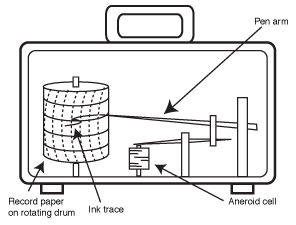Weather: Is the Pressure Getting to You?
Is the Pressure Getting to You?
The seventeenth century was quite an age of discovery. Evangelista Torricelli, a student of Galileo, invented the first mercurial barometer. It consisted of a glass tube open at one end and closed at the other. The open end was covered and immersed into an opened container of mercury. The cover was removed, and the mercury moved up the tube, about 30 inches above the container. That height represents atmospheric pressure. The weight of the atmosphere on the surface of the mercury exerts a pressure transmitted through the fluid, forcing it to rise. The greater the weight, the higher the rise. The barometric pressure seldom goes above 31 inches or drops below 29 inches. Normal sea-level pressure is 29.92 inches.
Weather-Wise
The type of barometer that you are probably most familiar with, the kind you see in stores and give as presents, is the aneroid barometer. As a rule, falling pressure means deteriorating weather, and rising pressure means fair or improving weather.
But the "inch" is really not a unit of pressure, or force per area. It is a unit of length. So a metric unit has been defined to describe normal atmospheric pressure, called a "bar," and the instrument becomes a "barometer." Actually, normal average sea-level pressure is 1.01325 bars, or 1,013.25 millibars (mb). The millibar is a commonly used unit of pressure.
During the same Galileo-Toricelli era, French scientist and philosopher Blaise Pascal discovered that air pressure decreases with height, and pressure changes at ground level at any one place can be related to daily weather changes. In his honor, the newest unit of pressure has become the hectopascal (Hpa). The pascal (Pa) is one hundredth of a millibar. The hectopascal is one hundred pascals and is the same as the millibar. So 1,000 mb and 1,000 Hpa are the same.

Barograph—trace of atmospheric pressure.
A two-and-a-half-foot tube is kind of awkward to keep around the house, and the need for a smaller and more practical device led to the development of the aneroid (without liquid) barometer. Instead of the expanding and shrinking of a mercury column, an expanding and contracting metal chamber does the work. Much of the air has been evacuated from the chamber, so slight changes in pressure around it cause it to respond by shrinking if the pressure increases or expanding if the pressure decreases. The metal chamber is attached to a pointer that indicates the pressure—the basic design of most barometers, including the home variety. A barograph (shown in the following figure) allows the pressure to be recorded on a rotating drum so that a time series analysis of pressure can be made. This works similar to a thermograph.
By the way, altimeters work just like barometers. Because the pressure decreases with height, these instruments are marked off in meters or feet rather than millibars or inches. The pressure drop with elevation is proportional to the change in height.

Excerpted from The Complete Idiot's Guide to Weather © 2002 by Mel Goldstein, Ph.D.. All rights reserved including the right of reproduction in whole or in part in any form. Used by arrangement with Alpha Books, a member of Penguin Group (USA) Inc.







